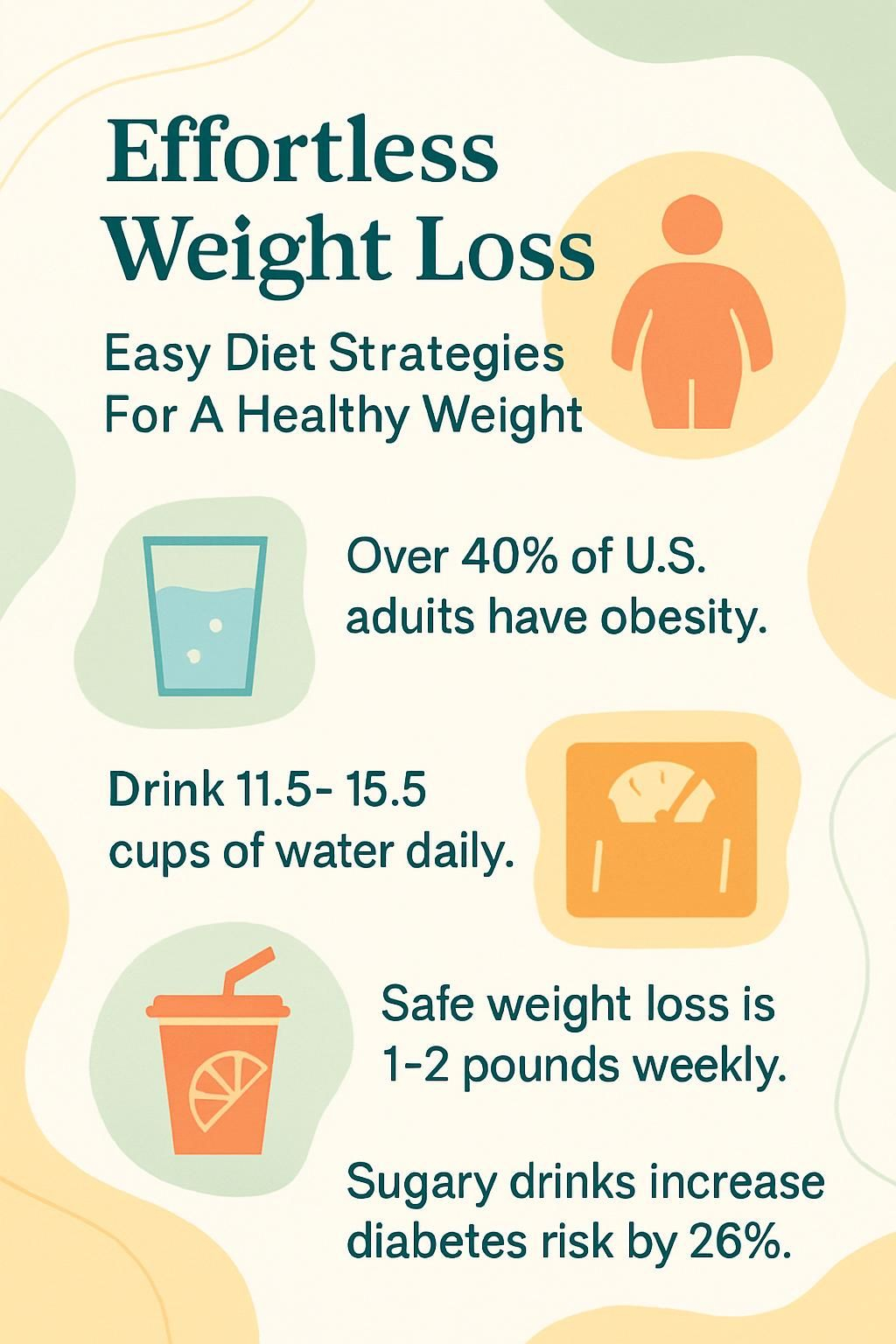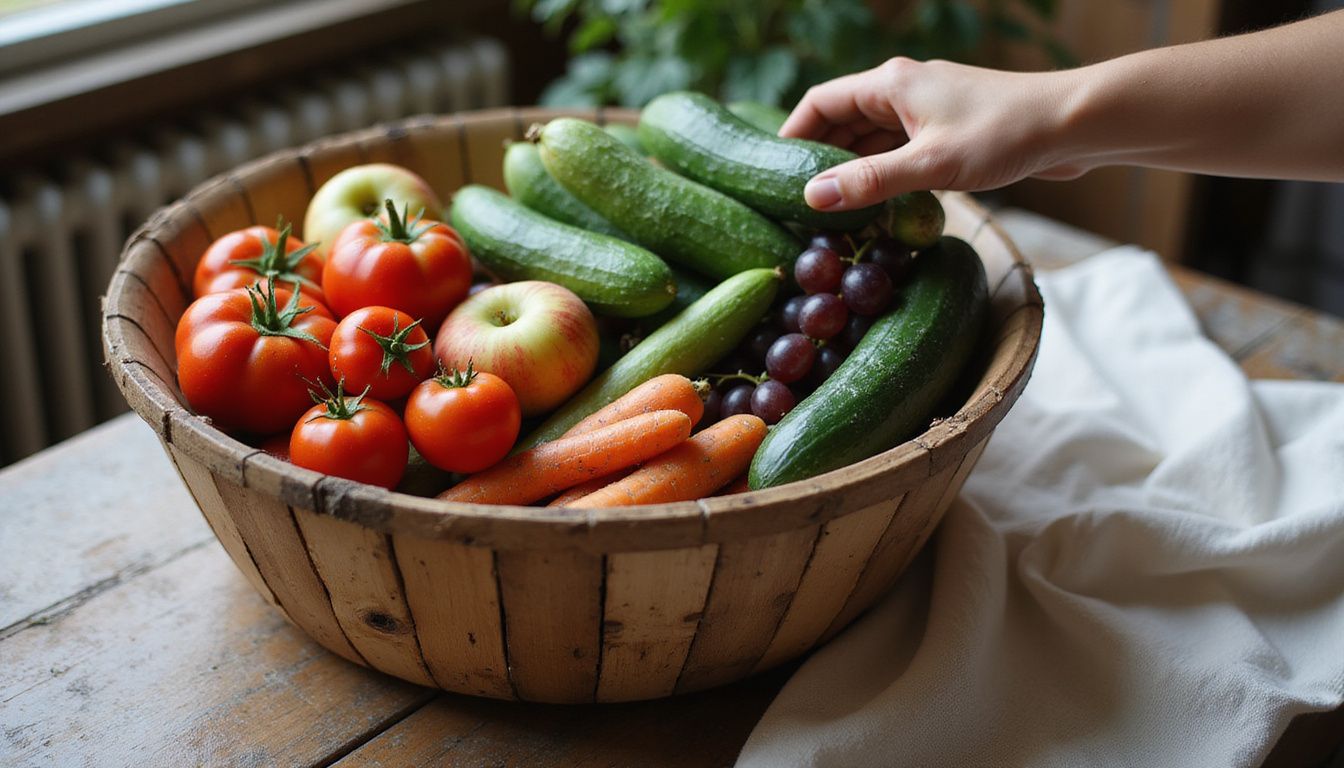Effortless Weight Loss: Easy Diet Strategies For A Healthy Weight
Our Nutrition Assistant AI Suite will transform your body. You will lose fat, get toned, and build muscle. Gain confidence and optimal health.
Want to lose weight but feel stuck in a maze of rules and plans? You are not alone. More than 40 percent of adults in the United States live with obesity, raising the risk of heart disease, type 2 diabetes, and stroke.
This guide shares an Easy Weight Loss Diet that uses simple, science-backed steps. You will find practical tips that fit real life so steady weight loss feels doable.
Key Takeaways
- Over 40% of U.S. adults have obesity, which increases the risk of heart disease, type 2 diabetes, and stroke. Weight management supports long-term health.
- Portion control, nutrient-dense foods, and enough water, about 11.5 cups for women and 15.5 cups for men daily, support safe weight loss of 1 to 2 pounds per week.
- Mindful eating and patterns like Mediterranean, low-carb, or high-protein diets can support weight loss and improve markers linked to chronic disease.
- Limiting processed foods, sugary drinks, and fried fast foods helps reduce extra calories and lowers health risks.
- Meal planning and balanced plates with fruits, vegetables, lean proteins, and healthy fats improve success and daily energy, in line with USDA guidance.

Why Is Maintaining a Healthy Weight Important?

Keeping a healthy weight lowers your risk for high blood pressure, type 2 diabetes, and other health conditions. It also supports daily energy and helps you feel stronger during routine activities.
What Are Common Challenges People Face When Losing Weight?
Many people struggle because high-calorie foods are everywhere and often cheaper. Processed snacks and fast food are easy picks on busy days, which makes change tough.
Stress and poor sleep can raise hunger hormones like ghrelin, which drives cravings. Motivation can dip if the scale plateaus for a while, which is common in most weight-loss programs.
Staying active is hard when life gets crowded. Some people feel isolated if family and friends eat differently. Support from others helped me stick with healthier habits and made the process feel normal.
You will face setbacks, but each healthy meal helps you move closer to your goal.
With these obstacles in mind, the next section outlines core ideas that make weight loss feel easier and more consistent.
Core Principles of Effortless Weight Loss
These core ideas make your diet strategy simpler. They also help you build habits you can keep.
How Can Portion Control Help With Weight Loss?
Smaller portions help you manage calories and support a safe weight loss plan. Many people see steady progress, about 1 to 2 pounds per week, using basic tools like smaller plates or pre-portioned snacks.
Swaps add up fast. One slice of whole grain bread instead of two at breakfast, or a cup of chickpea salad in place of a large burger meal at lunch, can cut hundreds of calories without feeling deprived.
Using a kitchen scale at dinner or boxing half a restaurant entrée helped me stay on track. Learning serving sizes reduced mindless eating. Choosing nutrient-dense sides like broccoli or sweet potato kept me full with fewer calories.
After portion control, focus on foods that deliver more nutrition per bite.
Why Should I Choose Nutrient-Dense Foods?
Nutrient-dense foods pack vitamins, minerals, and fiber with fewer calories. Beans, vegetables, fruits, whole grains, and lean protein help you feel satisfied and support weight loss.
A cup of spinach provides iron and vitamin K with very few calories. A small apple adds fiber that keeps you full. I swapped sugary snacks for carrot sticks and Greek yogurt and felt more energetic within two weeks.
People who eat more nutrient-dense, lower-calorie foods lower their risk of cardiovascular disease and type 2 diabetes. These choices build healthy habits that last.
How Much Water Should I Drink to Stay Hydrated?
Hydration supports digestion, energy, and appetite control. Health experts suggest about 11.5 cups of fluids per day for women and 15.5 cups for men, from beverages and food.
Water before meals may reduce calorie intake. Dr. Brenda Davy from Virginia Tech University noted that people who drank water before meals lost modest weight over time in randomized trials [1]. I keep a bottle nearby during work. Small sips across the day make it easy to meet my goal.
[1] Davy BM et al., Obesity (Silver Spring). 2010 Jul;18(7):1415-22.
What Is Mindful Eating and How Does It Aid Weight Loss?
Mindful eating means paying attention while you eat. You slow down, notice flavors and textures, and track hunger and fullness signs. People who use mindful eating often eat fewer calories and still feel satisfied.
This practice reduces overeating of high-calorie foods like desserts or packaged snacks. It also helps you spot emotional triggers, such as eating chips when stressed. I found I ate large portions during TV time, but felt fine with smaller servings once I checked my hunger signals.
Studies show mindful eating can support lower body weight and better blood sugar control. It makes healthy choices feel natural at lunch or dinner.
Easy Diet Strategies for Weight Loss
Small, consistent changes work best. Simple recipes and smart planning support your goals without making meals boring.
How Can I Add More Vegetables and Fruits to My Diet?
Vegetables and fruits are low in calories and high in dietary fiber. They keep you full and help you lose weight.
- Start meals with a vegetable soup or salad to add nutrients while lowering total calories.
- Replace some rice or pasta with sautéed onions, garlic, or zucchini for more fiber and fewer starches.
- Layer tomatoes, lettuce, cucumbers, or scallions into sandwiches, tacos, wraps, and tuna salad.
- Pick citrus slices, apples, or berries for snacks to cut added sugar and boost vitamin C.
- Stir spinach or kale into omelets or scrambled eggs to increase volume without many calories.
- Dip carrot sticks or bell peppers in hummus instead of chips to reduce fat from fried foods.
- Top pizza or cutlets with mushrooms, olives, tomatoes, onion rings, and a light sprinkle of mozzarella.
- Add sunflower seeds to salads or yogurt bowls for texture and healthy fats that support heart health.
- Blend smoothies with leafy greens and banana or citrus juice if whole produce is hard to eat.
- Swap sugary desserts for fruit salad with a squeeze of lemon or balsamic vinegar to steady blood sugar.
Prepping chopped veggies on Sundays made it easier for me to toss them into soups and sauces all week.
Why Are Whole Grains Better Than Refined Grains?
Whole grains like quinoa, brown rice, and oats keep their bran and germ. These parts contain fiber, vitamins, and minerals. Refined grains lose many nutrients during processing.
A cup of cooked quinoa has about 5 grams of fiber, while white rice has about 1 gram. Fiber helps you feel full, supports digestion, and may lower the risk of hypertension and type 2 diabetes. In reviews and meta-analyses, higher whole grain intake is linked to less heart disease, including lower heart attack risk.
Whole grains also help with weight loss. Fiber slows digestion so you feel full longer. I switched from white bread to whole wheat tortillas and noticed steadier energy.
Include lean proteins with whole grains to support muscle and hunger control.
What Are Good Sources of Lean Protein for Every Meal?
Lean protein helps you feel full, supports muscle, and can reduce heart risk factors. These options are easy to use in a healthy meal plan.
- Skinless chicken or turkey offers high-quality protein with little saturated fat. Grill, bake, or sauté to limit added calories.
- Fish such as salmon, cod, tilapia, and tuna supply lean protein and omega-3 fats. Many Mediterranean-style menus feature fish twice a week.
- Eggs are affordable and versatile. One large egg provides about 6 grams of protein.
- Low-fat dairy like Greek yogurt, cottage cheese, and skim milk provides protein and calcium with less fat.
- Legumes, including lentils, beans, chickpeas, and peas, offer plant protein plus fiber for fullness.
- Tofu and tempeh, both made from soy, provide complete protein without cholesterol.
- Lean beef, such as sirloin tip or eye of round, delivers iron-rich protein when cooked with minimal oil and simple seasonings like black pepper.
- Seafood options like shrimp or crab add variety with very little fat. Try them boiled with spices instead of butter sauces.
- Nuts, including almonds and walnuts, provide protein and healthy fats. Keep portions small since calories add up quickly.
- Plant-based meat alternatives can be high in protein. Check labels for lower sodium options.
After shifting from mostly beef to more legumes on my provider’s advice, I had more energy and lost 10 pounds in three months.
How Do I Use Healthy Fats Without Overdoing It?
Measure fats like olive oil, avocado, and nut butters with a spoon. Aim for one to two small servings per meal. For example, use one tablespoon of olive oil to sauté vegetables, or add a quarter of an avocado to a salad.
The Mediterranean diet features extra-virgin olive oil and nuts, yet too many calories from any fat can slow weight loss. Choose whole foods like almonds, walnuts, or fatty fish and check labels for serving sizes.
Research shows replacing saturated fat with unsaturated fat improves heart health without raising kidney problems. A sensible target is about 0.5 to 1 ounce of nuts or seeds per day.
Popular Diet Approaches
Several diet patterns can support weight loss and better nutrition. The best plan is one you can follow comfortably.
What Is the Mediterranean Diet and How Does It Work?
This diet focuses on vegetables, fruits, nuts, whole grains, beans, and olive oil. Fish and poultry appear more often than red meat. Processed foods, refined grains, and sugary items are limited.
Studies suggest people with obesity may lose weight with this pattern, especially with regular physical activity. Research also links it to lower risks of cancer and heart disease.
If you are pregnant or have diabetes, talk with a healthcare provider before starting a new plan. Many people find this diet tasty and easy to maintain.
How Does a Low-Carb Diet Help With Weight Loss?
Low-carb diets cut foods high in sugar and starch. This shift can help your body burn stored fat for energy.
People often eat fewer calories and feel less hungry on low-carb plans. For those with diabetes, lowering carbs may help control blood sugar. Focus on lean meats, nuts, seeds, and non-starchy vegetables to get protein and fiber that keep you satisfied.
What Are the Benefits of a High-Protein Diet?
High-protein diets support fullness, which helps with portion control and snacking. Getting about 25% to 30% of your daily calories from protein can help you lose body fat while keeping muscle.
Protein has a higher thermic effect, meaning your body uses more energy to digest it. Sources include eggs, chicken breast, tofu, nuts, and beans. I had fewer sugar cravings after adding grilled chicken or Greek yogurt at lunch.
This approach protects muscle during weight loss, especially if you are not lifting weights. Rotate protein sources during the week so meals stay interesting.
How Does Intermittent Fasting Support Weight Loss?
Intermittent fasting changes meal timing. A common method is 16:8, fasting for 16 hours and eating within an 8-hour window.
Research shows time-restricted eating can lower daily calories without strict counting. During fasting, your body uses stored fat for fuel. Some studies also show better insulin response and a healthier metabolism. I set a phone reminder for my eating window, which made it easier to stay consistent.
Practical Meal Planning Tips
Planning ahead helps you stay consistent. It also reduces last-minute choices that can derail a healthy diet.
How Can I Plan Meals Ahead to Stay on Track?
Block a short time each week to plan meals and snacks. Make a simple list, then shop only for what you need. This reduces impulse buys and saves money.
Batch cook or prep ingredients, like washing and cutting vegetables, to save time on busy days. Keep quick, healthy snacks ready, such as nuts and washed fruit. I once prepped all my lunches on Sunday. It kept me away from vending machines at work.
People who plan meals tend to meet their goals more often and report better diet quality.
What Does a Balanced Plate Look Like?
The USDA “MyPlate” guide makes balance easy. Fill half your plate with fruits and vegetables. One quarter should be whole grains, such as brown rice or quinoa. The last quarter is lean protein, like grilled chicken, tofu, eggs, or beans.
Add a small portion of nuts or seeds for healthy fats. Eating this way kept me from overeating snacks at night. Drink water with each meal to support hydration and digestion.
What Are Some Easy-to-Cook Recipes for Weight Loss?
Quick recipes keep your diet simple and satisfying. Choose whole ingredients, lean protein, and plenty of vegetables.
- Grilled chicken with mixed greens, dressed with olive oil and vinegar.
- Scrambled eggs with spinach and tomatoes for a filling breakfast.
- Baked salmon with lemon and broccoli for omega-3 fats and fewer calories.
- Quinoa salad with black beans, bell pepper, cucumber, lime juice, and cilantro.
- Greek yogurt with berries and chia seeds for a light snack or breakfast.
- Roasted sweet potatoes and Brussels sprouts topped with chickpeas.
- Steamed tilapia or cod with asparagus and a side of brown rice.
- Stir-fried tofu with snap peas, carrots, garlic, ginger, and low-sodium soy sauce over cauliflower rice.
- Lettuce wraps with ground turkey, onions, tomatoes, and avocado slices.
- Vegetable soup with carrots, celery, onions, tomatoes, and green beans in low-sodium broth.
During busy weeks, I make grilled chicken salads. They take about 15 minutes and fit my weight loss plan.
Foods to Focus On
Choosing the right foods makes weight loss easier to sustain. These picks support energy and nutrition.
Which Vegetables and Fruits Should I Eat More Of?
Focus on foods that are filling, low in calories, and high in fiber. They help control hunger and support a healthy weight.
- Leafy greens like spinach, kale, and romaine add volume with few calories.
- Cruciferous vegetables such as broccoli, cauliflower, and Brussels sprouts offer fiber and vitamins.
- Berries, including blueberries, strawberries, and raspberries, bring antioxidants with modest sugar.
- Apples and pears have high water content that curbs hunger between meals.
- Citrus fruits like oranges and grapefruits provide vitamin C with few calories.
- Carrots, bell peppers, and cucumbers make hydrating, crunchy snacks.
- Tomatoes add lycopene and hydration benefits with very few calories.
- Sweet potatoes provide complex carbs and steady energy compared to white potatoes.
- Melons such as cantaloupe and watermelon hydrate with natural sweetness.
- Grapes can be frozen for a portion-controlled treat. Watch serving sizes.
- Avocados supply heart-healthy fats. A few slices on toast kept me full during busy mornings.
What Whole Grains Are Best for Weight Loss?
Whole grains support steady energy and satiety. They also deliver fiber and key nutrients.
- Brown rice provides more fiber than white rice, helping stabilize blood sugar.
- Quinoa offers protein, fiber, and minerals for long-lasting fullness.
- Oats supply beta-glucan, a soluble fiber that may lower cholesterol and boost satiety.
- Barley has a chewy texture and soluble fiber that supports digestion and blood sugar control.
- Bulgur cooks fast and adds bulk to salads or soups with few calories.
- Whole-wheat pasta provides more nutrients and fiber than regular pasta.
- Air-popped popcorn is a low-calorie, high-fiber snack when made without butter.
- Millet is easy to digest and provides magnesium with some plant protein.
Choosing whole grains improves fullness and flavor. Next, pick protein sources that help you stay satisfied.
Which Protein Sources Are Healthy and Effective?
Protein supports muscle and helps control hunger during weight loss. These options are lean and practical.
- Eggs provide complete protein, about 6 grams per egg.
- Skinless chicken breast offers around 26 grams of lean protein per 3-ounce serving.
- Greek yogurt has up to 17 grams of protein per 6 ounces and adds calcium.
- Salmon and tuna deliver about 22 to 25 grams per serving plus omega-3s.
- Tofu offers about 8 grams per 3-ounce portion and absorbs flavors well.
- Lentils provide about 9 grams per half cup cooked plus fiber.
- Low-fat cottage cheese gives about 14 grams per half cup and works as a quick snack.
- Lean beef like sirloin supplies about 23 grams and also provides iron.
- Edamame packs about 18 grams per cup and cooks quickly.
- Turkey breast delivers about 25 grams of lean protein per serving.
Greek yogurt is my go-to breakfast. It keeps me full until lunch without extra prep time.
What Are Healthy Fats I Should Include?
Healthy fats support brain function and hormone balance. Include them in modest amounts to avoid extra calories.
- Avocados contain monounsaturated fats and fiber that promote fullness.
- Olive oil works well for cooking and salads, and it supports heart health.
- A small handful of almonds or walnuts provides omega-3s and protein.
- Chia or flaxseeds add plant-based omega-3s and fiber to oatmeal or yogurt.
- Fatty fish like salmon, mackerel, or sardines offer EPA and DHA omega-3s that lower inflammation.
- Natural nut butters give creamy texture and steady energy in small portions.
- Use canola oil instead of butter to reduce saturated fat.
Foods to Avoid or Limit
Some foods slow your progress. Limiting them helps you keep a steady calorie intake and better health.
Why Should I Avoid Processed and Packaged Foods?
Processed foods often contain added sugar, unhealthy fats, and sodium. People who eat more of these foods tend to gain more weight.
The CDC reports that over 70% of daily sodium comes from processed and restaurant foods. Too much sodium can raise blood pressure, which increases heart disease risk.
Many packaged snacks add calories without vitamins, minerals, or fiber. Cooking simple meals at home gives you more control over ingredients.
What Are the Effects of Sugary Snacks and Drinks?
Sugary snacks and drinks spike blood sugar and insulin, then leave you hungry again. Adults who drink one or more sugary beverages daily have a 26% higher risk of type 2 diabetes than rare drinkers.
High sugar intake also raises the risk of heart disease and fatty liver. I cut soda, and my afternoon hunger and energy crashes eased within a week. Water and whole foods keep energy steadier.
Why Limit Fried and Fast Foods?
Fried and fast foods often contain unhealthy fats, sodium, and lots of calories. Eating them often is linked to weight gain and higher risk of heart disease and type 2 diabetes.
A medium order of fries can have over 300 calories and nearly 20 grams of fat. I swapped weekly fast-food lunches for simple homemade meals, like grilled chicken and vegetables. Within a month, I felt more energetic and saw the scale move.
What’s Wrong With Refined Grains and White Bread?
Refined grains and white bread lose fiber, vitamins, and minerals during processing. For instance, white bread has about 0.6 grams of fiber per slice, while whole wheat has more than 2 grams.
Low-fiber foods can spike blood sugar and leave you hungry sooner. Studies link higher refined grain intake with more weight gain and a higher risk of type 2 diabetes.
Summary: Refined grains make weight control harder. Choose brown rice, oats, or quinoa for better fullness and steady energy.
Lifestyle Habits to Support Weight Loss
Your daily habits shape results. Support your diet with sleep, activity, stress care, and simple tracking.
How Does Quality Sleep Affect Weight Loss?
Sleep influences hunger hormones. Less than 7 hours of sleep is linked to higher ghrelin, which increases appetite, and lower leptin, which helps you feel full.
You might crave high-calorie snacks after a poor night’s rest. Good sleep supports metabolism and helps your body manage fat more effectively. Protecting sleep makes workouts and meal planning easier to sustain.
What Types of Physical Activity Are Best?
Activity burns calories and boosts mood. Pick options you enjoy so you can stay consistent.
- Brisk walking burns about 150 to 300 calories per hour for many adults.
- Strength training twice a week builds muscle, which raises metabolism. Bodyweight moves like squats and pushups work well.
- Swimming is gentle on joints and delivers a full-body workout.
- Cycling, outdoors or stationary, supports heart health and leg strength.
- Dancing is fun and gets your heart rate up quickly.
- Intervals mix short, hard efforts with rest. They can improve fitness in less time.
- Sports like basketball or tennis add social fun while you stay active.
- Yoga or Pilates improves flexibility, balance, and core strength, while easing stress.
Enjoyable activities are easier to keep, which supports steady weight loss.
How Can I Manage Stress to Support Weight Loss?
Stress can trigger emotional eating. Short breaks, deep breathing, brief walks, or meditation help reduce urges to snack.
Try 10 minutes of quiet time each day. People who practice mindfulness often have better control over eating. I used five minutes of breathing during hectic workdays, which helped me pause and make better choices.
Lower stress can also improve sleep, which supports hunger control and weight management.
Why Is Tracking Progress Important for Motivation?
Tracking shows your effort paying off. A food journal or app helps you spot wins like more vegetables or daily walks.
People who log habits are more likely to lose weight and keep it off. Seeing steady changes in water intake or portion sizes builds confidence. I tracked meals for two weeks and saw healthy choices turn into routine.
Monitoring progress keeps you focused and motivated.
Simple Swaps for Long-Term Success
Small swaps make a big difference over time. Pick changes that feel easy and repeatable.
What Are Healthy Alternatives to Sugary Drinks?
Sugary drinks add a lot of calories and make weight loss harder. Choose lower-sugar options to stay hydrated without the crash.
- Water with lemon, lime, or cucumber adds flavor without calories.
- Unsweetened iced tea, green or herbal, offers taste without added sugar.
- Sparkling water with a splash of 100% fruit juice gives a soda-like feel.
- Infused water with berries, mint, or citrus encourages steady sipping.
- Black coffee or coffee with a dash of milk keeps calories low.
- Low-sodium vegetable juice is a savory, nutrient-rich choice.
- Low-fat milk or fortified plant milks, like almond or soy, add protein and nutrients with less sugar.
- Low-sugar kombucha can support gut health with less sugar than soda.
- Mix 100% fruit juice with water to reduce total sugar per serving.
- Homemade iced green tea delivers hydration with antioxidants.
How Can I Replace Unhealthy Snacks With Better Options?
Choosing nutrient-dense snacks keeps energy steady and supports weight loss. Keep options simple and ready to go.
- Air-popped popcorn instead of chips for fewer calories and more fiber.
- Fresh fruit, like an apple or berries, in place of candy.
- Low-fat Greek yogurt with nuts instead of ice cream to add protein and healthy fat.
- Baby carrots or celery with hummus instead of crackers and dip.
- Homemade trail mix with unsalted nuts, seeds, and a little dried fruit.
- Whole grain rice cakes topped with avocado instead of pastries.
- Water or herbal tea instead of flavored sodas or energy drinks.
- Low-fat cheese sticks or hard-boiled eggs instead of processed spreads.
I started swapping afternoon chips for an apple with peanut butter. I felt full longer and had steadier energy at work.
Why Choose Air-Popped Popcorn Over Chips?
Air-popped popcorn is a lighter, more filling snack than chips. It supports weight management without sacrificing crunch.
- Air-popped popcorn has about 31 calories per cup. Potato chips usually have around 150 calories per ounce.
- Popcorn is a whole grain and provides more fiber per serving than most chips.
- Plain popcorn has little added fat or sodium if you skip butter and salt.
- The natural crunch is satisfying, which helps reduce mindless snacking. Switching to popcorn during TV time helped me eat less out of habit.
- People who choose lower-calorie snacks like popcorn tend to weigh less over time.
- Flavor popcorn with herbs or nutritional yeast instead of cheese sauces or heavy dips.
- Air poppers and pre-portioned bags make it convenient for busy days.
Smart snacking lays a foundation for better dairy choices that support your goals.
What Are Better Dairy Choices for Weight Loss?
Smarter dairy picks reduce calories and saturated fat while keeping protein and calcium. These swaps help you stay in a calorie deficit.
- Low-fat or nonfat milk instead of whole milk to cut calories and saturated fat.
- Greek yogurt for higher protein that supports fullness.
- Cottage cheese as a slow-digesting snack that curbs hunger.
- Part-skim mozzarella or reduced-fat cheddar to keep flavor with less fat.
- Plain yogurt instead of sweetened varieties to avoid added sugars.
- Whipped or light cream cheese on toast to save calories.
- Read labels, since some “light” products use sweeteners that may trigger cravings for sweets later.
I swapped whole milk for unsweetened almond milk at breakfast and felt lighter with steadier midday energy.
Benefits of Easy Diet Strategies
Simple strategies make healthy weight loss feel achievable. They add up day after day.
How Do These Strategies Support Sustainable Weight Loss?
Portion control, nutrient-dense foods, and hydration help you maintain a steady calorie deficit without extreme rules. Studies from the National Institutes of Health suggest slow, steady loss of 1 to 2 pounds per week is safer than fast loss^1.
Mindful eating helps you notice hunger and fullness cues, which lowers overeating. Replacing refined grains with whole grains and adding lean protein improves fullness so you eat less later. High-fiber foods, such as fruits, vegetables, and whole grains, may reduce the risk of regaining weight^2.
Small actions, like water before meals or filling half your plate with vegetables, build routines that last for years.
…
^1 National Institutes of Health, “Choosing a Safe and Successful Weight-Loss Program”, 2021
^2 Harvard T.H. Chan School of Public Health, “Carbohydrates: Whole vs. Refined Grains”, 2022.
How Can Diet Improve My Energy Levels?
Balanced meals with whole grains, lean proteins, fruits, and vegetables keep blood sugar steady. Foods like whole oats, brown rice, chicken breast, spinach, and berries prevent crashes.
Even mild dehydration can cause fatigue, so drink water regularly. I swapped chips and soda for apples with peanut butter and sparkling water, and my afternoon focus improved.
Nutrient-dense foods provide lasting fuel compared to processed snacks.
Can These Diet Changes Reduce Chronic Disease Risks?
Eating more fruits, vegetables, whole grains, and lean protein can lower risks for heart disease and type 2 diabetes. Five servings of fruits and vegetables per day may cut heart disease risk by up to 20 percent.
Choosing whole grains instead of refined grains helps control blood sugar and reduce inflammation. Replacing trans fats with healthy fats like olive oil supports heart health.
Conclusion
Reaching a healthy weight does not require extreme rules or hours of daily exercise. Simple strategies like portion control, more fruits and vegetables, whole grains, and lean proteins make weight loss manageable.
Mindful eating and good hydration support steady progress. These habits can raise your energy and lower the risk of chronic disease over time. If you have a medical condition or take medications, talk with a healthcare professional before changing your diet or activity. Small steps, repeated often, lead to lasting success.
FAQs
1. What are some easy diet strategies for healthy weight loss?
Simple approaches include eating more vegetables, choosing whole grains, and drinking water instead of sugary drinks. Research from the CDC shows that people who eat more fiber-rich foods often lose weight with less effort.
2. How can I make weight loss feel effortless?
Plan meals ahead to avoid unhealthy choices and keep healthy snacks nearby. A study in Obesity Reviews found that meal planning helps people stick to their goals and reduces stress about food decisions.
3. Are there any proven benefits to slow, steady weight loss compared to quick fixes?
Yes; studies published by the National Institutes of Health show that gradual changes lead to lasting results while crash diets often cause rapid regain of lost pounds.
4. Can you share a personal example of an easy strategy for losing weight?
I started swapping soda for water at lunch each day; over several months, I noticed my energy improved and my clothes fit better without strict dieting or counting calories.
Summary: Easy diet strategies such as increasing fiber intake, planning meals, making small swaps like water for soda, and focusing on gradual progress help support long-term healthy weight management according to credible research sources.







